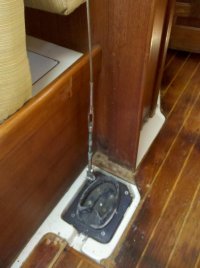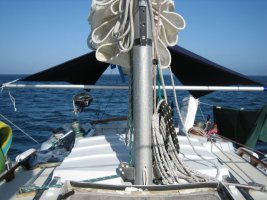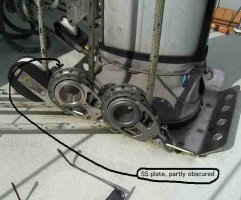You are using an out of date browser. It may not display this or other websites correctly.
You should upgrade or use an alternative browser.
You should upgrade or use an alternative browser.
What does this do?
- Thread starter C Masone
- Start date
-
- Tags
- mast base tie rod turn buckle
u079721
Contributing Partner
That's the tie down to keep the deck from deforming under the compression of the rigging. The tension on the outboard shrouds tends to pull the sides in, which tends to make the deck deflect up. The tie down counteracts this force. On my 38 it was a solid pipe from the overhead to the grid by the mast, while on some other models it's a cable from the overhead to a fitting on the side of the mast itself.
And also -- to keep the cabin top from being pulled upwards by the multi-hundred # pull on halyards.
Actually quite a bit more than that for a spinnaker halyard when the boat broaches!

The vang tackle can exert a lot of force, too.
LB
Actually quite a bit more than that for a spinnaker halyard when the boat broaches!

The vang tackle can exert a lot of force, too.
LB
Sven
Seglare
And also -- to keep the cabin top from being pulled upwards by the multi-hundred # pull on halyards.
Do you have a picture that shows how your halyards pull up on your deck ?
You might want to get that fixed.

-Sven
Only our cat was "fixed"...
The actual force vector would be at 45 deg. so the force is outward as well as upward.
Still quite substantial.
The load on those flat halyard organizers is high too, but it's mostly all in shear.
This presumes that your boat has the stock (for the 80's anyway) turning block sheaves on the collar plate bolted down to the housetop around the hole where the spar pierces the housetop.
:nerd:
Loren
Do you have a picture that shows how your halyards pull up on your deck ?
You might want to get that fixed.
-Sven
The actual force vector would be at 45 deg. so the force is outward as well as upward.
Still quite substantial.
The load on those flat halyard organizers is high too, but it's mostly all in shear.
This presumes that your boat has the stock (for the 80's anyway) turning block sheaves on the collar plate bolted down to the housetop around the hole where the spar pierces the housetop.
:nerd:
Loren
Sven
Seglare
This presumes that your boat has the stock (for the 80's anyway) turning block sheaves on the collar plate bolted down to the housetop around the hole where the spar pierces the housetop.
Do you have a picture please ?
If the vertical load is not tied to the spar rather than the deck I would not want to sail on that boat.
I have seen boats where the halyards go straight down to blocks that lead the lines aft without first going through blocks attached to or loading the mast first for the vertical loading and those are jobs done by someone who did not study structural engineering.
I really need to see a picture of what you are referring to as the hold-down on Senta II for example is in no way designed for vertical halyard loads.
-Sven
Sven
Seglare
Here's a picture that shows how the halyard was run on La Petite to ~only put horizontal loading on the deck. There is a very small angle so there is probably a 2-3% of the line loading actually applied vertically to the deck.
It is a nice coincidence that this arrangement also clears the sliding hatch but that is definitely not the reason for the arrangement.
-Sven
It is a nice coincidence that this arrangement also clears the sliding hatch but that is definitely not the reason for the arrangement.
-Sven
Attachments
Dear friend, No, no, no, don't listen to any of them especially Sven. That cable exerts an upward force on the keel and is there to prevent the boat from sinking. Without it in place she'd sink like a rock. It's the same principle we've all employed over the years when wading out into the water at the beach, we pull our pant legs up otherwise if we didn't they'd sink into the water. That's why I only sail our boat on the hard. Cheers, Glyn Judson, E31 hull #55, Marina del Rey CA
Sven
Seglare
Dear Sven. That cable exerts an upward force on the keel and is why I only sail our boat on the hard. Cheers, Glyn Judson, E13 hull #55.25, Marina del Reyless CA

-Sven
I do not have a photo of the inside with its "tie rod" but here is the outside. Starboard side. Almost out of sight in this angle is the top of the little ss plate that is right behind the mast base. That plate has a welded-on ss tang that protrudes down thru the cabin top. It links to a short ss cable that connects to a turn buckle that goes to a T fitting on the side of the spar inside the cabin.
LB
LB
Attachments
Last edited:
Sven
Seglare
I do not have a photo of the inside with its "tie rod" but here is the outside. Starboard side. Almost out of sight in this angle is the top of the little ss plate that is right behind the mast base. That plate has an ss tang that protrudes thru the cabin top. It has a short ss cable and connects to a turn buckle that goes to a T fitting on the side of the spar inside the cabin.
It is hard to see from that picture if you are talking about a SS plate other than the one that the halyard blocks are attached to, but I am positive that the turnbuckle is there to hold down the SS plate that the blocks are attached to, not the deck. That is how the vertical halyard load is tied to the spar instead of being tied to the deck.
Thanks for the picture,
-Sven




